#making them into mathematically the same entity
Explore tagged Tumblr posts
Text
tardis/time lord symbiosis as a mathematical operation along the lines of a complex multidimensional trigonometric proof. transforming each side until they’re not only equivalent but actually identical. ?
#trig proof is the only way i can frame what i’m thinking of in terms of math i know lol#^barely passed grade 12 calculus and then promptly forgot it all#but do you see my vision#making them into mathematically the same entity#isomorphic controls work on similar principles i imagine#p#dw#time lords#tardises
10 notes
·
View notes
Text
Back in November, Elon Musk professed his abiding belief in open government. “There should be no need for FOIA requests. All government data should be default public for maximum transparency,” he tweeted.
“We post our actions to the DOGE handle on X and to the DOGE website,” he boasted in the Oval Office last month as his young child wandered randomly around the room full of reporters. “I don’t know of a case where an organization has been more transparent than the DOGE organization.”
That was a lie.
At that time, the DOGE website had virtually no information on it. And DOGE’s public pronouncements are often either mathematically impossible, or, like the $50 million “condoms for Gaza” claim, simply false. In fact, DOGE staffers have taken great pains to obscure their identities, with Musk calling it a crime to dox them. The agency even spent a month refusing to say in court or anywhere else who the DOGE administrator was.
As a practical matter, this makes it impossible for the public to see what DOGE is doing. From a legal standpoint, it allows the administration to take a strategically ambiguous stance in hopes of shielding DOGE from judicial interference.
But the jello against the wall strategy has largely failed in court, and Monday a federal judge ordered DOGE to pony up and begin complying with a Freedom of Information Act (FOIA) request filed by Citizens for Responsibility and Ethics in Washington (CREW).
An agency by any other name …
While Elon Musk was preaching the gospel of transparency, the Trump administration was taking deliberate steps to hide what DOGE was doing. Specifically, Trump signed an executive order inserting DOGE into the skin of an existing agency, the United States Digital Service, and then redesignating it as part of the Executive Office of the President (EOP).
The order specified that DOGE is not a federal agency, a legal distinction which turns out to be critical in at least three pending lawsuits. Because if DOGE is not an agency, then it doesn’t have to comply with federal records laws or have its leader confirmed by the Senate. But only an agency can claim authority to shut down great swathes of the federal bureaucracy — something Musk brags about doing on the daily. And so the Justice Department has tried to situate itself in the cut, arguing that DOGE is simply an “instrumentality” of the president.
In a case called AFL v. Department of Labor, a consortium of labor unions sued to block DOGE personnel from rifling through sensitive personal and financial information on the DOL’s servers. They argued that, if DOGE is not itself an agency, then it can neither park employees at agencies under the Economy Act of 1932 nor access sensitive government records under the Privacy Act of 1974.
Judge John Bates denied the unions’ request to lock DOGE out of the database, ruling that entity was pretty clearly an agency since it’s engaged in a wholesale reshaping of the federal government.
“[P]laintiffs have not shown a substantial likelihood that USDS is not an agency,” he wrote, adding that “it follows that plaintiffs have not shown a substantial likelihood on the merits of their Privacy Act claim, for without the argument that USDS employees may not be detailed under the Economy Act, the Privacy Act claim all but disappears.”
But he called out the government for its “desire to escape the obligations that accompany agencyhood — subjection to FOIA, the Privacy Act, the APA [Administrative Procedures Act], and the like — while reaping only its benefits.”
“And so USDS becomes, on defendants’ view, a Goldilocks entity: not an agency when it is burdensome but an agency when it is convenient,” the judge observed drily.
Judge Bates’s colleague Judge Tanya Chutkan came to much the same conclusion in a case called New Mexico v. Musk. There a coalition of states argued that DOGE is a federal agency, and thus Trump needed to nominate Musk as its director and submit him for Senate confirmation under the Constitution’s Appointments Clause.
The judge denied the states’ motion for a temporary restraining order barring DOGE from wreaking havoc on the federal government, finding that the states had failed to demonstrate the requisite danger of imminent, irreparable harm to justify a TRO. But she made it clear that she agreed that DOGE is definitionally an agency.
Plaintiffs raise a colorable Appointments Clause claim with serious implications. Musk has not been nominated by the President nor confirmed by the U.S. Senate, as constitutionally required for officers who exercise “significant authority pursuant to the laws of the United States.”
On the face of it, both sets of plaintiffs lost, but the failure to secure emergency relief shouldn’t obscure the importance of the courts’ rulings. Because if DOGE is a federal agency, it’s subject to FOIA, the Privacy Act, and the APA — which is exactly why President Trump tried to preemptively declare it a non-agency by fiat.
… would still be subject to FOIA.
As Judge Bates pointed out, designating DOGE as part of the EOP was an obvious attempt to exempt it from multiple federal laws. Indeed, spokesperson Katie Miller acknowledged as much on Twitter when 404 Media reported that DOGE was getting off Slack to evade FOIA.
“Per the Executive Order [DOGE] was reorganized under the Executive Office of the President and subject to Presidential Records,” she wrote.
Under the Federal Records Act (FRA), documents generated by federal agencies are presumptively public and subject to FOIA. But under the Presidential Records Act (PRA), presidential records are not subject to FOIA, and the president can functionally lock up them up for five years after he leaves office. Worse still, if the president refuses to comply with the PRA and destroys documents, as Trump did routinely, there’s essentially no remedy.
Not every document created in the EOP is a presidential record immune from FOIA. The DC Circuit ruled that the Office of Science and Technology and the Council on Environmental Quality, both of which are part of the EOP, are subject to FOIA because they exercise substantial independent authority. But the administration takes the position, at least as a legal matter, that Musk and his minions are simply “advising” President Trump, and lack any authority of their own.
It’s a preposterous stance in light of multiple executive orders giving DOGE hiring and firing authority, as well as access to databases at every government agency. But when CREW filed FOIA requests for DOGE documents, they got no response. And so on February 20, the nonprofit sued and filed a motion for preliminary injunction forcing the government to cough up the data by March 10 so that Congress could be informed of DOGE’s activity before passing a budget.
The DOJ tried mightily to duck the agency issue, leaning instead into CREW’s demand for expedited processing and complaining in their opposition memorandum that “the primary effect of granting a preliminary injunction would be to disadvantage other requesters who would be pushed further back in the FOIA processing queue.”
But at the hearing, the government admitted it was refusing to complete the FOIA request on any timeline because it believes that DOGE is not an “agency” susceptible to FOIA. And like Judge Bates and Judge Chutkan, Judge Christopher Cooper wasn’t buying it.
The judge pointed to DOGE’s “substantial authority independent of the President” as laid out in the executive order and later confirmed in public statements by both Musk and Trump.
And the judge noted that DOGE is actually exercising that independent authority: After Musk tweeted that he’d spent the weekend “feeding USAID to the wood chipper,” the agency was functionally shut down.
“For all these reasons, the Court concludes that USDS likely qualifies as an agency for the purposes of FOIA,” he wrote.
Judge Cooper also tweaked the government for playing games with regard to DOGE’s status.
“The Court finds it meaningful that in its briefing and at oral argument, USDS has not contested any of the factual allegations suggesting its substantial independent authority,” he wrote, referring back to Judge Bates’s “Goldilocks” comment. And while Judge Cooper wasn’t willing to enforce the March 10 deadline, he did order expedited processing, with rolling production to begin immediately.
FOIA requests often take years, but, as the court notes, DOGE is used to moving fast when it comes to burning down the government.
“In the less than two months since President Trump’s inauguration, USDS has reportedly caused 3% of the federal civilian workforce to resign, shuttered an entire agency, cut billions of dollars from the federal budget, canceled hundreds of government contracts, terminated thousands of federal employees, and obtained access to vast troves of sensitive personal and financial data,” Judge Cooper wrote, adding that, “given that [DOGE] is apparently not processing any other requests, the Court doubts it would impose much of a burden on the department to expediently process CREW’s request.”
He ended by ordering DOGE to preserve all documents, in light of multiple media reports that DOGE employees are communicating via Signal and non-government emails.
The ruling is a total loss for the Trump administration, which will doubtless appeal in hopes of continuing to hide what Musk is doing. But, barring intervention by a higher court, we’ll soon see the results of CREW’s pared-down query:
The narrowed USDS request seeks, in each case from January 20, 2025, to the present: “all memoranda, directives, or policies regarding changes to the operations of USDS”; organizational charts for USDS; ethics pledges, waivers and financial disclosures of USDS personnel; “all communications with the office of the Administrator of the USDS regarding actual or potential changes to USDS operations”; and “all communications between USDS personnel and personnel of any federal agency outside of the Executive Office of the President regarding that agency’s staffing levels (including any effort to reduce staffing), treatment of probationary employees, contract and grant administration, access to agency information technology systems, or the authority of USDS in relation to that agency.”
And perhaps more importantly, the unanimous rulings that DOGE is an agency may provide a handle for outside litigants and Congress to grab hold of it before it succeeds in decimating the entire federal government. Let the FOIA and APA cases begin!
55 notes
·
View notes
Text
For what it's worth, my opinion on the Teleporter Discourse is that continuity is a suspect idea, full stop.
Useful on human scales, certainly- most of our basic day-to-day thinking depends on models of the world as being made up of discrete objects with some degree of persistence in time. Those models underly the basics of language, of law, of practical morality, and any number of things. And, in turn, those intuitions serve us quite well.
But it must be acknowledged that none of this is actually real:
"By convention sweet and by convention bitter, by convention hot, by convention cold, by convention color; but in reality atoms and void."
Down in the subatomic realm somewhere, maybe there's some sort of discrete actually-existing objects that can sincerely be said to persist in time. But that's nothing that particularly concerns us, when we talk about handbags and hand grenades. Our world, the world of human bodies and teleporters, is one in which we use social conventions, heuristics, and imperfect models to tell a story about "objects" that "persist." And it is just that, a story! Nothing more, nothing less.
So of course the teleporter discourse admits no objective solution, because none of this stuff has objective solutions. Just greater or lesser degrees of consensus, more when a phenomenon is familiar to us and well-predicted by the "objects exist" model of the world, less so when things are imagined, hypothetical, and unfamiliar. But ultimately it's exploiting the same kind of ambiguities as the "when does a collection of sand grains become a pile?" type of question- it's an ambiguity that exists in familiar and everyday situations too. And our answers might be more or less useful, but never more correct as such.
...but that's not quite true either, is it?
First, contra Democritus, there is a class of entity that does seem to be both macroscopically relevant and persistent in time, albeit in an unusual way. Mathematical and deductive claims, natural laws, and similar things in that class- entities that don't seem to exist physically at all, but which are nonetheless consequential for our world regardless of whether somebody believes in them. Entropy doesn't exist "by convention". It can and will dictate the limits of your steam engine no matter how many times you tap your heels together and make a wish.
And second of course there's consciousness itself, the whole reason we're having this conversation in the first place. For those of us poor monkeys just doing our best to keep that sacred flame lit, consciousness defies many of our reductionist instincts. People love that "atoms and the void" quote, but they always forget the other half of the dialogue:
The Intellect: By convention sweet and by convention bitter, by convention hot, by convention cold, by convention color; but in reality atoms and void. The Senses' reply: Miserable Reason, it's from us that you get your evidence, and yet you try to overthrow us? The overthrow will be your downfall!
Consciousness upends almost all of this; we have to accept the evidence of our senses, but we also have to accept the reality of our senses.
This puts us in a tricky position, because we're caught on the horns of this dilemma- is consciousness more like a handbag, or is consciousness more like a law of nature? And there's no obvious way to answer that question. But I am, at least, pretty sure that reductionism is true of matter, that is, of the world of physical objects.
In other words, I'm confident in the following conditional: if consciousness is a thing that atoms do, then its persistence is as illusory as that of any other physical object. It is only if consciousness is an immaterial process, that it can be said to have genuine continuity.
This leaves me pretty relaxed about teleporters. Either we are material phenomena, in which case this moment is all that we ever truly have- or we are not, and what do we have to fear from the mere dissolution of a few atoms?
23 notes
·
View notes
Text
Dungeon Meshi Liveblog: I should make a fucking...(food) web of connected concepts with panels that connect them...
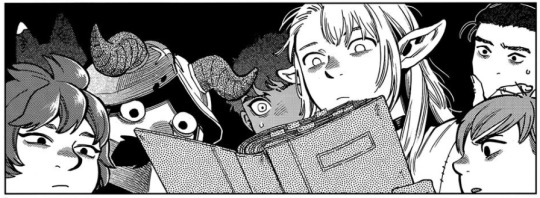
I love how Kabru is just part of this friend group, now. He invited himself and no one's questioning it. Laios invited him to lunch later, and that counts.
.

I love how everyone is varying levels of "oh fuck" until we get to The Current Party, where it's:
Senshi: thinking intently, a little grimly, about how he could butcher and cook this
Marcille: a dash of 'oh fuck', but also sad, in the way of watching a friend slide down a slippery slope
Chilchuck: incredible dad energy on this line, honestly.
.
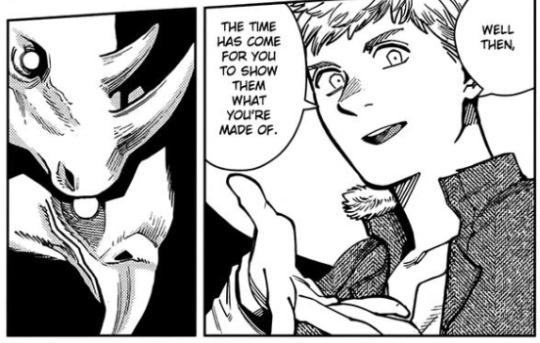
don't you give my son orders, you piece of shit. you aren't worthy of being lord of anything. you protect nothing, wish to help no one, except your own desires. (The Demon never should've been alive at all. It's not suited to it.)
.

This is gonna look sooo cool animated in color.
.
I might actually be more offended by the demon wearing Kensuke like normal than by the whole wearing of Laios's body? It's so symbolic.
.


I want to know how the ancients achieved that - binding the demon such that, while underground, it could only warp reality in service to a living being's desires. Though really, that seems to be how it's always operated - the only desire it ever expressed for itself was to eat the desires of others. Otherwise, it's only shown fulfilling wishes, before it's locked in the dungeon as well as after.
But I wonder if having a physical form gives it the ability to want more? Does it hunger and third and want to rest, now? DOes it really feel a yearning not just for the completion of its plan, but for the open sky and sight of the world which it hasn't seen in so long?
.
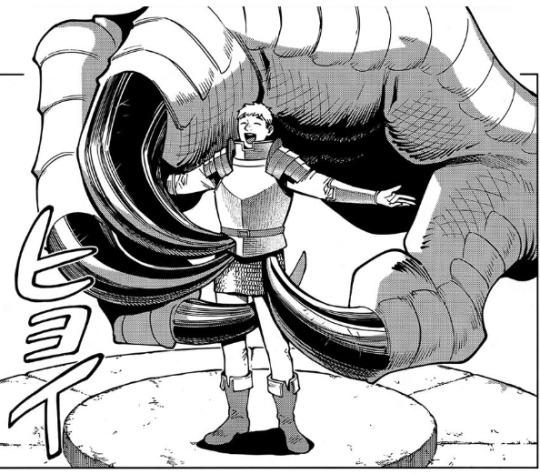

Needless to say, we love a visual parallel.
.
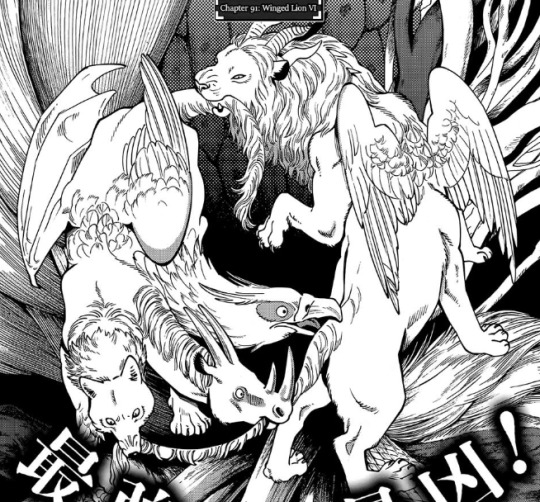
yep, this sure is the Eating Each Other Cyclically chapter! (This is the Eating Each Other Cyclically story, actually. It's called the ecosystem!)
.

oh I hate this actually. It's scary in a real way. I do not like being forced to acknowledge that Chilchuck is much, much smaller, weaker and more fragile than Laios. I do not like seeing him curled up and helpless and unable to ever reconnect with his family.
.

Freak cubed! Actually, how many times has it gone back and forth, now...?
the lion swallowed all of them
Laios ate hte lion in order to swap bodies (ish)
honestly I feel like the demon being counts as eating him in turn. Making Laios's body part of itself, you know? That's eating.
(monster!)Laios ate demon(!Laios)
demon(!Laios) is now eating (monster!)Laios
...so, Freak^5
.

The parallel to Marcille snapping at Laios to drop the plant seeds in Chapter 2... Love how every now and then people resort to yelling at this man like he's a dog. Truly, he is a beagle of all time (eats Things) ('Things' is an unlimited category of which the details are best left unknown)
.
THIS IS IT, BITCHES! THESIS TIME!! I'M GONNA USE "IF AND ONLY IF LIKE IT'S A GODDAMN MATHEMATICAL PROOF, BECAUSE THAT'S HOW THIS HAS BEEN PRESENTED THROUGHOUT!
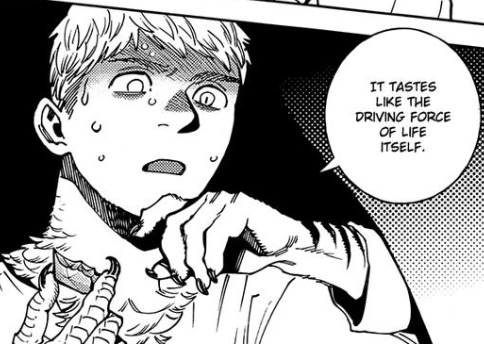

LIVING IFF EATING IFF HUNGERING IFF WANTING.
TO DO ONE IS TO DO THEM ALL, FOR EVERY ENTITY IN EXISTENCE: EVERY RACE, EVERY CREATURE.
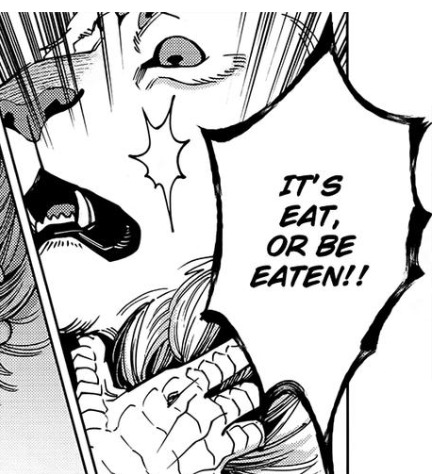
LIVING AND DYING, EATING AND KILLING AND BEING KILLED AND BEING EATEN, ARE ALL SIDES OF THE SAME COIN. YOU WILL DO BOTH.
IT'S CALLED THE ECOSYSTEM.
And it applies to social structures as well as biomes btw.

YOU WILL ALWAYS EAT, AND THEN YOU WILL ALWAYS HUNGER FOR THE NEXT MEAL. BECAUSE YOU ARE STILL ALIVE.
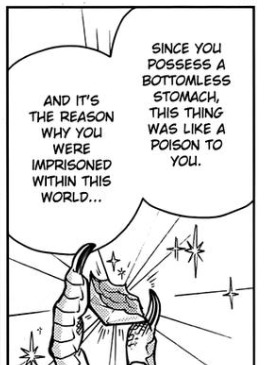
Which is why hunger(/living) is poisonous to this infinite being, btw: the cycle is infinite, sure, but specifically because any single creature within the cycle is finite. To exist as part of the cycle, the world, breaks the infinite being, even as the infinite being inevitably destroys the world.)
But most of all:
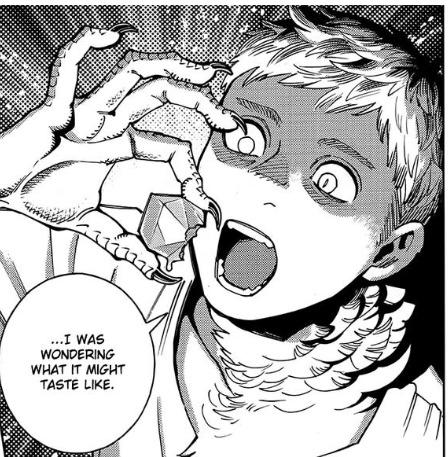
EATING (IFF BEING EATEN IFF LIVING IFF WANTING) IFF UNDERSTANDING IFF BEING CONNECTED/BEING PART OF
THE FUNDAMENTAL [DESIRE/HUNGER/LIFE EXPERIENCE/CONNECTION/SHARED UNDERSTANDING] OF BEING ALIVE IN THIS WORLD IS [EATING/LIVING/DYING/KILLING/WANTING/HUNGERING/BEING CONNECTED/UNDERSTANDING OTHERS/BEING UNDERSTOOD/WANTING TO BE UNDERSTOOD/WANTING TO UNDERSTAND/WANTING TO BE CONNECTED]
...WHICH DOES ALSO INCLUDE (MONSTERFUCKER) VORE

(This is the fucking...Theseus wrestling the Minotaur statue...of this world... People are going to make this statue of King Laios Eating the Demon... It's going to be in museums...and in the palace... The true curse here is that Marcille is going to have to see versions of this motif for her entire excruciatingly long life...)
120 notes
·
View notes
Text
Are XFOHV + The subscriber specials canon?
This is a question I’ve had for a while. It’s a little hard to tell sometimes what is and isn’t canon to the bfdi universe.
Right now, we know that BFDI, BFDIA, IDFB, BFB, TPOT, BFDI mini, and TFI all take place in the same timeline. But Jacknjellify also makes other BFDI related content. They’ve made shorts (like Fish and Chips or Claustrophobes Nightmare) as well as subscriber specials.
Now, we can be pretty sure that the shorts aren’t canon. The world literally fucking ends in Claustrophobe’s Nightmare. But the subscriber specials are much more complex to talk about. I’m gonna put all of that under the cut because I have A LOT to go over ^_^
So, first of all. XFOHV and the subscriber specials are often grouped together because both focus solely on the algebraliens. XFOHV is probably canon, because it’s been referenced MANY times within BFDI, and there’s just. No reason for it to not be canon. It wouldn’t really cause any timeline issues, so I feel confident saying that it’s canon.
The real issues pop up when we look at the sub specials. First of all, in the latest sub special an all powerful entity showed up and kidnapped all of the numbers and overflowed the Earth with lava. Now, if the sub specials are canon, shouldn’t we be seeing the effects of that? Shouldn’t Two be missing because they got kidnapped? Shouldn’t the grass and trees be dead after the lava flood?
But nope! In TPOT 16, we see Two is still depressed in their room, and the plant life is thriving!
Not only that, but in TPOT 15, we can see a planet with numbers and mathematical symbols all around it. But in the sub specials, the equation playground is on Earth!
So then, the sub specials can’t be canon…. Right….?
But then, what about the ending scene of TPOT 15? The kidnapped contestants found a door in One’s dimension which led them to the equation playground. But, we already established that the playground exists in BFDI. This doesn’t definitively prove the sub specials are canon.
Now, one thing I do wanna mention is the number planet. I actually don’t think that the equation playground is on that planet, simply because the number planet is literally fucking pink ???? The equation playground looks like it’s on Earth. It makes more sense that way.
And, although we don’t see the subscriber specials having any effect in BFDI, they could take place in the past or future. If the specials take place before TPOT started or after it ended, it would make sense why we don’t see them influencing each other very much. But then, that creates even more plot holes. Like, Seven says One is his friend, but I assume her evil plan would be revealed sometime during TPOT, so… Yeah that’s weird.
Anyways. This was supposed to be a theory post where I prove the sub specials are canon, but I honestly don’t know.
I want them to be canon because. I don’t want this to be another fnaf situation… There are already multiple BFDI timelines, do we really need ANOTHER one??? It’s way more fun if XFOHV and the sub specials are canon, and it opens the door for a lot more interesting theories!
But on the other hand, most people have already accepted that the specials aren’t canon, and it would create some plot holes if they were. So idk. Give me your thoughts
19 notes
·
View notes
Text
Vacant Reality Ad Infinitum:
A PSA regarding the dangers of reality jumping and multiversal travel
In this essay: I'm not gonna tell you not to, but I will tell you why leaving your reality of origin would be an excessively bad idea, and why you should seriously weigh your options before committing to an irreversible decision. I will also give guidance on how you can mitigate the dangers of this journey, should I be unable to convince you to stay home.
Introduction:
So, you've noticed that you are, in fact, not alone in this reality. There's a whole sea of worlds out there where anything and everything has already or will soon happen. You probably have good reason to shed this mortal coil and play in the big sandbox of the gods, and what's more, you have found a proverbial bus out of town that can make your wildest dreams possible.
This, of course, I believe to be a bad idea. But I know that's not a very compelling argument, so allow me to elaborate.
Subject 1: Equivalent Exchange and Higher Beings
You are most likely a being comprised of some mixture of meat, elements, and life force. These elements are necessary to the continued function of your reality. Removing said elements in any quantity will unfailingly lead to the slow and painful death of every renewal and repair cycle your reality has in place. Are you leaving your reality because it is already dying? It probably just needs a pinch of salt and one or two human equivalent souls.
This is the easiest problem on the list to fix. Just grab a copy of yourself from the reality you are jumping to and send them back to yours. This is just a matter of ensuring nothing has been physically lost or gained from either realities in the exchange.
But why do you need to fix it, I hear you ask? Why not just leave the old reality behind to die, and jump to another? Well that bit earlier about "sandbox of the gods" was not a figure of speech. Whether ancient primordial forces, old gods, or simply other reality jumpers, those who have confirmed themselves to a single or multiple realities have a vested interest in keeping said realities healthy. Also, if you are reading this, I can guarantee they are more powerful than you, and importantly, more experienced. They will find you, and you will be neutralized. Exact methods will vary, but you do NOT want to be neutralized.
Subject 2: Personal Relationships
You no longer see people as individuals, but as whole species of the same person. That's not your friend. That's a version of someone who was your friend. You will see your loved ones hate and kill each other, assuming they don't get to you first. People are now little more than machines for your use. You know all of them by name and you will have no idea who they are. Accomplishments by you and yours mean nothing because those accomplishments have been made infinitely by infinite people for infinite reasons. Trivial nonsense made for war, crimes against humanity made for fun, nothing means anything in the infinite reality. Even surrounded by loved ones, you will not see them. Only the infinite faces they have worn, and the infinite souls who have with them. And you, will be a god to them. A cryptid entity that knows more than they could ever forget. A thing.
Subject 3: Let's go Gambling!
Probabilities do not exist when reality jumping. When the possibilities are endless, so too are the odds. You will never accomplish exactly what you set out to do. Previously infanitesimal chances of failure are now guaranteed. Nothing is too hard to find because it has happened an infinite number of times, but so has literally everything else. You will succeed at everything you wanted to accomplish on your journey, but you will die tired, scared, and alone. Because there is a chance it could happen, it will.
Subject 4: YOU Will Not Return HOME
No being has endured the ravages of infinity. It's just not mathematically possible. You will crave the comfort of home and it will not return to you. Every jumper who I have personally met is currently trying to destroy a single target. Trying to reach a single warm embrace. Trying to just set things back to the way they were. An infinite number of stranded astronauts. And many of them were you. And you just want to go home.
When you find 'home', it will be wrong. An imperfect copy so close to the original you can not find it's flaws. But you will feel them. Even if you could find your exact point of origin, YOU will not return. Only something wearing your skin. Something that knows the Vacant Reality Ad Infinitum and cannot return to how things were. Something that knows everything. Something that knows how everything will end. A Thing that has seen everything end.
I N F I N I T E L Y
In Conclusion:
Please don't. Use your newfound power to make this reality what you want it to be. Break the rules that cause grief. Make new rules to ensure your goals. You have the power to change reality itself, so don't just replace it with another. You will find resistance, and it will be difficult. But, there is a chance. A small chance. A chance so infantesimaly small that .most wouldn't even consider it possible. But it is there. And very real. And it will be lost the moment you leave.
Thank you for your time-
Captain Fless Roicaff
9 notes
·
View notes
Text
When we attempt to parse and analyze our knowledge, and how we come to know, we first take account of the fact that we are using various sentences as a means of interacting with the world: that is, we interact with the world around us by the mediation of how we communicate to others. Indeed, we communicate by more than even language, and become aware of a far wider world of signs used for these various purposes. But when we attempt to know something, and to convince others that we know such, inevitably language is our preferred medium, and preferably an argument analyzable into distinct sentences. Perhaps not all, but at least some of this language is effective by virtue of conveying information, expressing something true or false about the world—and a reasoned argument at least must be primarily analyzable into such. Indeed, many sentences seem to convey the same information and to express the same thing, so people designate these shared meanings as the propositions a sentence expresses (however we wish to further explicate the nature of such propositions), and these sentences can be said, by virtue of these propositions, to be true or false. But if such declarative sentences are capable of relating to the world in this way—by some means of correspondence between the world and a proposition that makes them true or false—then what must the world be like? It would seem to involve a structure itself akin to the structure of an informational sentence, a factual structure: the world is itself analyzable into states of affairs, into facts about individuals having such and such properties and being in such and such relations to one another. We land upon a factualist ontology, i.e., what there is, is facts and the components of facts. But what are we really comparing our propositions against? We only know of their truth or falsehood by virtue of our own experiences or observations of the world: this world of states of affairs, qua a world of things capable of confirming or falsifying our propositions, is a world of experienced objects, of facts considered as parts of our own stream of consciousness. The further question, then, is what exactly is our experience itself, or our stream of consciousness? They are perspectives on facts, ways that we feel and react to facts; but are they, themselves, beyond the realm of knowledge and not capable of themselves being known about? That is, do we now include a kind of entity in our ontology that is not a fact nor a component of facts, but some other elliptical unknown entity? Our ability to even discuss facts as being experienced or observed, and thus to discuss some aspects of our experience truthfully, indicates that they themselves are also facts. Indeed, we are capable of remembering past experiences, of comparing statements and claims against these experiences and knowing aright or wrongly how they occurred. We are, that is, capable of some level of introspection that provides experiences as themselves data we may know about. It may be the case that useful science must always abstract away from this level of introspection to the more controlled component of it that we may term third-person data, which picks out the more precisely communicable parts of our experience of a shared spatiotemporal world, capable of mathematical description. Nevertheless, this shared mathematical world seems to only be a portion of a wider stream of feelings, whereby we are aware of—and learn about—not merely the structural or mathematical features of facts but also qualities we find embedded in such structures. The world is thus not a world merely of states of affairs, but a (factual) world of pure experience, where each fact is itself either a fact experienced or an experience of other facts.
3 notes
·
View notes
Text
@klonkkukin:
yes, i think i understand; mathematical objects are definable to the extent where one can say they are identical, whereas the variety in biological "objects" is so pronounced it calls into question the validity of this kind of lateral differentiation completely. this seems to be a property that comes with existing in non-ideal spaces. your answer might depend on whether your object is completely definable within ideal space, which you seem to be leaning away from.
re: biology: yeah I think that's a large part of it (also just the nature of categorization of large numbers of real entities), but it's also relevant that evolution makes it impossible to draw even mostly-neat lines between species. we all share common ancestors through continuous lines of descent. species simply can't be an equivalence class (as a platonic view would like it to be) or else everything would be the same species, so we have to draw essentially arbitrary lines on what makes something "different enough" to be a new species.
re: mathematics, it's hard to discuss without slipping into implicitly platonist language so just mentally insert any necessary caveats, but: I would say that mathematical objects aren't so much "defined in ideal space" as they are abstracted from others by forgetting all but a certain collection of properties. the things being abstracted may be real or mathematical: real-world spatial relationships, Euclidean geometry, metric spaces, topological spaces, and so on. the properties of the abstractions are grounded in the selected properties of whatever they're abstracted from. but then what we call mathematical "equality" is a matter of equivalence regarding the properties under consideration, instead of identity as such. among mathematicians, category theorists are fairly honest about this; category theory doesn't prescribe a notion of equality on objects (leaving it to the individual categories), so category theorists love to talk about things as if they're equalities and then add "up to isomorphism". a lot of mathematics is, in a philosophical sense, doing the same thing but skipping the second step. tbf a lot of fields don't have an internal notion of "isomorphism", and it doesn't have any negative consequences for the field itself.
we could define totally arbitrary concepts in ideal space which aren't abstracted from anything else, but they wouldn't be of any mathematical interest so I wouldn't call them mathematics. their exploration would be more like Henry Flynt's idea of "concept art".
6 notes
·
View notes
Note
Hey, you, tell me about НИКТО НЕ ЗАБЫТ И НИЧТО НЕ ЗАБЫТО for the ask game!
Hi, you! Thanks for the ask!!
This one's a chapter from a longer fic I'm working on that I'm thinking of maybe going in a different direction with, so I'm potentially trying to rework it into a separate entity. It's set in the hunt for Bucky/Bucky making sure his handlers can't get their hands on him again. Lots of thoughts on necessary violence vs. revenge ft. some morally grey memories from the war. Excerpt below the cut:
“It’s a memorial poem,” Natasha says, her face an ironed out surface. In the sickly fluorescent light she seems almost immaterial, washed-out and half-there. Places where the present thins out so you can see what’s underneath, Steve thinks. Two points in time on top of the same head of a pin. “To the fallen in the siege of Leningrad.” He walks around her and up to the table carefully, as if afraid to jostle her too far out of this place and towards that other one, the transient overlap of now and then calling her home. He points to the words that first caught his attention, finger barely hovering over the smudged, fragile print. “That's kind of familiar, but my cyrillic's not all there. I don’t recognize the rest.” “We cannot list their noble names here, there are so many of them under the eternal protection of granite. But those who look upon these stones, know this,” she translates, voice going sandpaper-rough at odd intervals. She pauses as if reciting from memory, dredging the words up by force. Maybe she is. “No one is forgotten, and nothing is forgotten.” He traces the words on the paper, the ridges where the pen pressed too deep and harsh into the folds of the cursive, his attention snagging strangely on the unwieldy awkwardness of the handwriting. Left-handed, it occurs to him as if from a great distance. Bucky used to be left-handed. The breath he didn’t know he was holding rushes out of him sharp. “Steve.” The paper, the table, the grime on the tile. He can’t look at her. “It doesn’t have to mean anything.” “But you think it does. You think it means something.” She won’t say what she’s thinking again but if it's to protect Bucky or Steve or herself this time, he doesn’t know. “Tell me.” "I think he's angry." Her tone is restrained but in her old-young-ancient face, Natasha's eyes burn bright. "I think he wants them to know it." Fear is a powerful weapon, she'd said back at the motel. And they've used it one too many times. The pages from the file flash through his head, the detailed, mathematics-cool explanation of the use of the wrecked contraption in the middle of the room; the mask strapped to Bucky's face like a muzzle. "Good," he says finally when he can get his voice to come out even. Natasha’s expression withdraws back into that careful neutrality, but there’s a note of something fierce and complicated holding out at the very edges that just doesn’t fold as easy. "He might hurt a lot of people, Steve." He looks back at the handwriting for a moment longer, where the ink started bleeding from the pressure: Никто не забыт и ничто не забыто, like a threat and a promise. With quick movements he folds the paper and sticks it into his pocket, and then he’s turning for the door. “Then we figure out how to help him only hurt the right ones.”
#tag game#my fic#gyokujyn#these might be too long? but I don't know how to split them into snippets that make sense and also. idc this is fun#and I don't know when I'll have the time to finish and post the full work#asks
9 notes
·
View notes
Text
the thing is that there are two ways of looking at archangel-true vessel relationships (ok more than two but let’s go simple for now): each entity as fundamentally distinct from the other despite the similarities and fate connection, and each entity as being actually just a component of the other. two halves made whole in the poetical sense of partnership (each is one of two, 1/2) or in the more mathematical sense of being different facets of a single unit/each other’s shadow versions (each is .5 of 1).
most of the fandom focus has been on the relationship between two distinct individuals, which is fair enough but i do think canon (especially early on when the true vessels thing is introduced) invites you to think about both. and personally i’ve always been 100% willing to go in on the idea that an archangel and true vessel are facets of the same entity. i don’t think that is 100% accurate to what is going on, but i am willing to pretend it is. i don’t think that’s any more simplistic than over-simplifying the other direction and considering them totally distinct either.
and look ok. the thing is that two pieces of one individual just do not have to relate to each other the way two separate individuals do. finding new parts of yourself can be like meeting another person, like damn who even am i?? i’ve felt this way when dealing with particularly negative emotions, and when reckoning with parts of my identity i had either repressed or not ever needed to confront before. it’s weird and unsetttling, but i’m not literally a separate person from myself because of bits of me i dislike or feel alienated from. i do not consent, necessarily, to those parts of me being part of me, they just ARE. i can’t banish them just by saying i don’t want them in my life the way i (theoretically) could with another person (who i would hope would respect my boundaries). i can either decide to be how i am indefinitely, or i can accept that that’s part of me and try to change it. but that’s not the same as how i would interact with another person and it wouldn’t make sense to treat it that way (your mileage may vary, maybe you are better at self-distancing than i am). consent is a different experience when it’s about aspects of your actual self.
is that thee most accurate way of going about it? tbh i don’t really care because i do think it is THERE in the show, it’s a fair line of analysis even if it isn’t The Best, and it is what is most personally compelling and exciting to me.
and like yes i do call myself an archangel/true vessel shipper but am i really? i’ve personally never been sure. it’s more like selfcest to me than anything, mostly. and i totally get why that wouldn’t be for everyone but i think it at least partially explains why i have not. like. succeeded at or really enjoyed engaging with especially samlucifer in ways many other people do or assume that i would
13 notes
·
View notes
Text
i've been thinking about my y'shtola headcanons again and i'm trying to wake up for the day so babble post time:
is the 5th born of 12 daughters of y'rhul nunh, and the only daughter of y'ahna karho.
she was born with a weak constitution and barely survived infancy, a fact that made her mother suffocatingly protective of her.
she chose matoya as much as matoya chose her; y'shtola researched several potential mentors, and deemed matoya the perfect candidate due to her unwillingness to break to sharlayan's rules.
y'shtola sent her dozens of letters requesting matoya's tutelage, all of which were ignored. it was only when y'shtola physically appeared at the entrance of matoya's cave that the woman saw something special in her and took her on.
she studied hard at conjury expressly to combat her constitution so she could achieve whatever she set out to do.
she completed her apprenticeship with matoya at age 17, and joined the circle of knowing at age 18. she received her archon marks at age 23.
she's 33 years old when ARR begins. i've based this on a mix of headcanons as well as the fact her being 23 in ARR is mathematically impossible both because of 1.0's timeline and the fact her younger sister is canonically 27 in ARR.
(the breakdown goes like: becomes matoya's apprentice at age 7 (canon), studies under her until shes 17 (canon), joins the circle of knowing and first travels to limsa lominsa at age 18 (headcanon, as is everything after this). she's also 18 when old sharlayan announces they're recalling the dravanian colony, and is one of the first people louisoix recruits to the circle of knowing due to his respect for matoya. the circle works in secret for 6 of the 10 years sharlayan works to withdraw the colony; y'shtola receives her archon marks at age 23, a year before sharlayan finds out about the circle's treason and exiles its members. 4 years later, at age 28, 1.0 takes place, and five years after that, ARR. hence, 33.)
i headcanon that each seeker tribe has a number of clans, and each clan has a nunh; this is to account for the fact that seekers are NOT rare in ffxiv even when you only count npcs LOL. y'shtola's clan lives in the dravanian hinterlands, and many of its members studied in sharlayan. further, i headcanon the stripes on miqo'te faces to be tattoos, and that they also get these tattooed on the body based on traditions and achievements. seeker face tattoos are usually a commiseration for reaching adulthood, while seeker body tattoos often represent feats achieved by huntresses and men. y'shtola has no body tattoos, having never been a clan huntress, and her face tattoos were more or less insisted upon by her mother because it was 'proper'.
it's confirmed to be a bad translation that y'shtola's aethersight is "slowly killing her"; every other translation and the original text describes it more like it's taxing or fatiguing, not draining her life force. i headcanon that overuse of her aethersight gives her migraines, weakness, and muscle aches, and severe overuse leads to problems like irritable bowels and heart arrhythmias. it CAN kill her, but only acutely; with proper rest between uses, she's in no danger.
outside of combat and while not in her own home, y'shtola uses her aethersight near constantly. at home, she relies on familiarity with the furniture and a walking stick. in combat, due to the fatiguing nature of both her aethersight and her spellcasting, y'shtola uses 'snapshots' of the former to find enemies and quickly strike them. she often charges a spell before knowing where an enemy is, then 'peeks' right before firing. the downside of this is it makes her very immobilized, as she can't spend much time looking at the terrain around her, so moving risks running into unexpected obstacles, especially as bodies and debris fall.
aethersight is not the same as typical vision. it's more like a blue and white heat map, with aetherially-dense entities blue and aetherially-sparse entities white. (this can be seen in an alexander cutscene when the aether goggles are used.) she can't make out most details due to this; a person, for example, is more or less a silhouette of blue. she can read books easily though, because most ink is enchanted to be waterproof, fast-drying/non-smudging, etc, making it far more aetherially charged than the paper or bindings.
her "inexplicable fear of aureliae" is a result of her first trip to limsa lominsa, where on the ship taking her there, the deck was overrun by a swarm of the creatures. she also, tangentially related, absolutely hates seafood.
lesib! lebsibn! lisbab! women!
9 notes
·
View notes
Text
The Kaikainuchwer Empire is more of a way of life, rather than any institution. Individuals on the islands and along the eastern coast happened to speak one language and engage in a similar code of ethics, but there is no one to uphold any laws or claim any dominion. Only permanent settlements by this point are coastal villages, where a reliable food source comes from the sea. These communities are ruled by the exchange of favors - for the food that fishers delivered, they are now owed the repair of their rafts by carpenters. Ancient caste of Mediators administering the transaction of favors and resolving any disputes, in exchange for their share of food and services. Mediators have to keep in mind all of the affairs and perform resource management, therefore mediators are very educated, developing an alphabet for the language and mathematics.
Their codependency makes Kaikainuchwer societies welcoming as long as nothing goes wrong, but not allowing for mistakes. If one’s duty was not performed, they get penalties, or get exiled, depending on the necessity of the failed task and severity of the failure. Sabotage of a neighbor's labor, if properly investigated, is a death sentence. Mediators, considered an unbiased part of society, also perform the role of executioners. While the villages are organized, there is never a larger force governing those. There were several pirate societies that tried to establish control over the coastal areas, but they suffered from infighting and rebellions and never lasted for a sagnificent time.
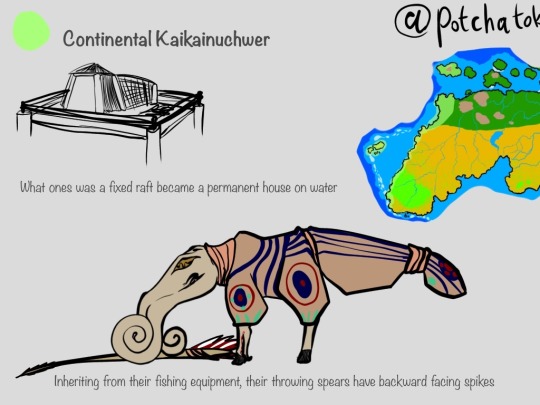
On the continent, the Kaikainuhwer spread over several climate zones. There are those who interact with jungle populations. These Kaikainuchwer must be the most inland of this culture. Savannah colonists are similar in their lives to islanders, because of the same climate, though they grow more militaristic with bigger predators and other Sutviprra tribes. When moving into temperate zones, they arrive into more forested areas and seas, abundant with big schools of fish, but temperatures become less comfortable. At first, they struggle to establish permanent settlements, but with arrival of North East Northern populations they manage to discover technology of clothes - unfortunately, the strategy used to open communication works no more - when winter closes in, resources get scarce and tribes become tense over territories they control. Kaikainuchwer, being smaller and less battleworthy get pushed into waterlogged areas of the forests, impossible to traverse if not for their rafts. Mostly subsisting on seafish in their diet, they also start to explore continental flora and fauna. Relatively late for Sutviprra, Kaikainuchwer started using throwing spears to hunt and forage for plants. In particular, they find plants, whose seeds are stored in pine-like clusters. This plant is very dependant on abundance of water and endemic to the north east swamps, and, if boiled in water, their pine becomes softer and possible to eat. They find it out because of animals, who also eat those pines, dip them in water to male it malleable, but there is also a myth.
Kaikainuchwer’s mythology/philosophy considers everything alive. They have a diverse array of rituals to worship or pacify every particular minor spirit, but main overincompasing entities are the sky and the sea. And so, once a continental Mediator was helping with a hunt, and witnessed a close lightning strike. Upon approach, she noticed that the entire batch of pine-plants shed their seeds, which were floating on the water surface. Suddenly, a lot of creatures, terrestrial, aquatic and flying started to feed on those seeds. The Mediator took this as a sign, took an uncooked pine home, boiled it and liked the resulting dish.
Later, when Kaikainuchwer started deliberately seeking and consuming it, it appeared to make them much healthier and stronger. It was attributed to special magical properties, real explanation was that their diet of mainly marine life brought dangerous levels of salt, mercury and made them develop overvitaminos.

#sutviprra#art#speculative biology#speculative evolution#worldbuilding#alien design#speculative botany#spec bio#spec evo#exobiology
9 notes
·
View notes
Text
World of Arturium: The Four Forces of Magic
The world of Arturium contains the myriad of natural forces present in the real world. But operating alongside and beneath it are four additional magical forces, all unique though the use of one is often derived from the others. These are the forces of Correspondence, Astronomy, Dominion and Alchemy. I'm pretty proud of these overall - figuring out the sources of magic so I know how they feel to use was a big deal I never satisfyingly solved until now.
Correspondence is the magic of sympathy, symbolism, narrative and intent. Its languages are Banrigh, Sylvan and Druidic with a lesser power within Elven. Their physical forms are totems, gifts, poetry, stories and art. When Moaven created the world of the Fey she made it in her image, a complex and ceaseless cycle of change, experimentation, life and death. Thus all things of that world are entwined with these core facets. Their motions, meaning and words are thus inherently powerful things, demanding that the Fey act with delicate and deliberate intent in all things so as to not wreak unintended ruin with their actions. With intent forming the best known components of it, Correspondence is seen as a graceful form of magic, hard to learn but supernaturally elegant. Indeed it is beyond many mortals to do so. Only the Fey are born with this magic at their fingertips, with mortals approaching it by one of two vectors, invitation or adoption as they are called by the fair folk. Invitation is the method by which a Faerie invites a mortal to taste their power, imparting ability to use it as a gift by the very same power that gives gifts their magic best known as pact magic. Adoption is instead the abandonment of contrivance of civilisation, the unlearning of mortal etiquette and convention and the adoption of the laws of correspondence that connect all living things. This is often understood by mortals as Druidism and similar practises. Despite being two sides of the same coin, Invitation and Adoption are regarded very differently by mortals and Faerie. For the fair folk invitation is the done method, to be invited in and accepted by the mothers of symbolic magic. Mortals by contrast balk and worry at such things, the flightiness and seemingly alien thoughts of the Fey making such deals shadowy occult things. Adoption by contrast is much more favourably regarded amongst mortals as a self-made thing, the adaptation of Faerie things into the mortal minds. Only a few fair folk take at this as a thing to be proud of though; most consider it tantamount to theft or murder, the taking and twisting of their birthright, not aided by the number of druidic practises that seem designed to counter or resist the Faerie.
Astronomy is the magic of heavenly bodies, physics and mathematics. Its language is Draconic. Its physical forms are orreries, navigational and star charts, mathematical formulae and geometric patterns. Dragons came to the world in the bones of Gavrail, an ancient sleeping star dragon who crashed into the world when it was young. The impact awoke his spirit to divinity so great was his power, as his body died and decayed into the world. These bones became Furrahum and the blood became magma, and when eruptions spewed from the earth the dragons were born from them with magic on their tongues. This is the nature of Astronomy; a god, a species and a language born from the death of a celestial entity and a cataclysmic celestial event and thus all they are tied closely to the physical laws of the world. To be a mage of Astronomy is to be a scientist and philosopher, decrypting the scientific laws to harness the power of dimensions and motion. This is the form of magic most associate with the concept of magic in their mind, requiring no involvement with higher powers and going hand in hand with scientific progress. Some dragons do find some slight in their language being appropriated, but unlike that of the Fey they are of the mortal world and so most content with themselves with being embodiment of this magical structure.
Dominion is the magic of command, decree and transaction. Its languages are Celestial and Infernal. Its physical forms are gold, contracts, codices, statues and armaments. Dominion frames the world as products of its wants, carved along the lines of moral laws set by the collective unconscious of all creatures. To a mortal, the idea of objective morality is a strange one and in a vacuum it indeed does not exist. But mortal actions and desires flow out from the material world, colouring the structure of the world with their hues. These colours run together into a web understood as the spectrum of cosmic morality - good, evil, law and chaos and from there, power springs. These forms of defined cosmic morality are all at their base means to control, to enforce one's will upon the world and its people though the methods may differ. Hence its magic is bestowed, passed down from the most significant beings of the world, the masters of Dominion in the worlds above and below. It takes the form of faith and dark dealings, oaths and accords to the whims of higher and lower powers. The chain of command and concept of hierarchy, loyalty to cause, are integral parts of this system. It has led to the generation of things such as holy orders and cults, which by definition require in groups and out groups, further delineating the divisions of power. As a result while those who employ Dominion as their power can still command a broad array of inherited power, some magic remains forever off-limits to them so long as they align with that paradigm. Dominion magic is of course hugely divisive but more so by its moral component than any specific facet to the magic itself.
Alchemy is the magic of materials, augmentation, transformation and chemistry. Its languages are Auran, Aquan, Ignan and Terran. Its physical forms are alloys, mixed materials, masterwork equipment, physical fitness and martial arts. Beneath what most mortals know lie certain fundamentals, building blocks of existence. The first layer is the elemental planes, the energy reactions that mix into new forms and below that is the astral oceans from which raw realty stems. In a perfect world these layers would remain separate but supporting, and this is not a perfect world. Cracks are pervasive throughout the planes, subtly affecting local geography or causing elementally-attuned births, scaling up to allowing travel between worlds or even the rare elemental storms. For one to utilise these building blocks it requires a certain amount of mastery of materials, similar to Astronomy but rather than physics and mathematics it is chemical and material science, decrypting how things react and combine in tandem with this leaking magic. An unintended aspect of magic, while elementally-fuelled mages do exist, the majority of utilisation of the paradigm of Alchemy is done by the mundane. The raw stuff of reality that leaks through these cracks is questing, unrefined and searching for purpose, definition. There are those who learn to identify materials marred by cracks in reality and alloy them with others, often using primordial tongues as their binding agents to craft potent magical items or command unexpected effects from them with no magical aptitude of their own. Others will learn focusing techniques and mastery of body that allow them to alloy with this questing power and take it into themselves, augmenting their body in ways that transcend the natural body.
#fantasy#pathfinder#ttrpg#magic#alchemy#devils#celestials#fey#Faerie#worldbuilding#fantasy worldbuilding
3 notes
·
View notes
Text
12/11 UPDATE
Just finished up with the semester! I was able to make A+'s in all of my courses. Even after a horrible final presentation I had to give for my final exam. But the classes I took this semester were Modern Physics Laboratory, Electricity and Magnetism, Thermal Physics, and Mathematical Physics II. I had planned to apply to work in the nanofabrication lab downtown but literally that same semester the founder of the lab left to a different school and now the website just doesn't exist at all. I'm guessing this was all for a reason but still I was so bummed!
Anyways I was able to sign up for my spring classes and I'll update them later but I'm taking a lot of general ed requirements and quantum mechanics, electrodynamics, and a research lab class. I really wanted to take the microscopy elective they were offering but the schedule was just not working with my other classes.
I was wanting to minor in astronomy and astrophysics but they weren't offering most of the electives this semester so unsure if that'll even be possible at this point lol.
I was accepted into a physics conference at Tulane University in New Orleans omg. Still figuring out the travel details with my school. I can't wait to goooo and just experience my first conference. Maybe this will make me a little less scared of future endeavors. I had a bad quasi-research experience while I was getting my degree in nanoengineering and I'm a little iffy on academia as my end goal now. But we'll see, maybe it was just a bad one-off type of thing.
Also built my first PC and it works so well, I can play all the Stardew mods I want!
A lot of applications are closing in December and January so I need to start applying for some things if I want a REU with a really big entity. I'm thinking about NIST and some electrical engineering type things. I still need to look into it. My university also gets a lot of funding for the summer, so that's an option too!
I also want to talk about my summer experience at Princeton and their plasma physics lab but I think that deserves its own post.
2 notes
·
View notes
Text
Information Sets Described: The Key to Machine Learning Mastery

In the saturated landscape of artificial intelligence, machine learning is a foundational field, teaching systems to learn from data without codification. A pivotal idea behind most algorithms for machine learning is the information set. You must understand information sets to attain Machine Learning Mastery, reducing complex issues and generating intelligent, adaptive systems. This paper will demythologize information sets and analyze their definition, characteristics, and significance in the broad framework of machine learning.
What is an Information Set?
Essentially, an information set is, in fact, a collection of indistinguishable states or circumstances from the perspective of some particular deciding entity. For instance, suppose a poker player; he is, of course, aware of his own hand but, on the other hand, less aware of the hands of his opponents. Furthermore, an information set includes possible hands an opponent may have based on their actions, thereby requiring a player to act on probabilities. In addition, dominion over Machine Learning depends, ultimately, on a deep understanding of how agents make decisions under incomplete information.
Major Features of Information Sets
There are several characteristic features that dictate the behavior of information sets:
Indistinguishability: The agent cannot tell between states in the same information set. This perfect lack of information is normal for most real-world scenarios.
Action consistency: Within an information set, the same action should be taken by the agent. If the agent took dissimilar actions within seemingly similar states, it would contradict the definition of the information set. Action consistency is crucial in decision making under uncertainty.
Uncertainty in Decision-Making: Sets of information force agents to decide based on probability and expected value rather than omniscience. This requires the use of strategies and algorithms designed to optimize results in a world of uncertainty. For Machine Learning Mastery, being able to handle uncertainty is most important.
Information Sets vs. Perfect Information
To make better sense of the value of information sets, it is helpful to put them in perspective against situations of perfect information. In chess, for instance, both sides have complete knowledge of the board position at all times. This is a game of perfect information. However, most real problems lack perfect information.
For example, consider an autonomous car driving down a busy street. The car’s sensors provide it with information about the world, but that information will be incomplete and potentially noisy. The car will have to act on the best it can infer from what it sees, with the knowledge that it cannot perfectly model other cars or pedestrians’ behavior. Machine Learning Mastery allows us to build robust AI systems that are able to deal with this complexity.
Use of Information Sets in Game Theory and Machine Learning
Information sets are a key concept in game theory; moreover, game theory provides a mathematical formalism for analyzing strategic interactions among rational agents. Additionally, there are many machine learning algorithms, particularly those used in reinforcement learning, that adopt much from game theory. Specifically, reinforcement learning is training an agent to act optimally in an environment so as to achieve a maximal reward. In fact, learning, in most situations, involves dealing with imperfect information and uncertainty.
For instance, imagine teaching an AI agent to play poker. In this scenario, the agent must strategically decide based on its hand, other players’ behavior, and limited knowledge of their cards during the game. Consequently, the agent comes to approximate the probabilities of different hands and make decisions maximizing its expected gain. Ultimately, mastering Machine Learning in game playing involves mastering information sets.
Applications of Information Sets in Machine Learning
Beyond game playing, information sets play an essential part to play in many other applications of machine learning:
Robotics: Robots operating in uncertain environments must make decisions from sensor readings, which are incomplete and noisy in nature. Information sets represent robot’s environmental uncertainty..
Finance: Financial markets are subject to uncertainty and incomplete information. Machine learning models used for trading and investing have a tendency to operate with sets of information to express the potential variability of future states of markets.
Cybersecurity: Detection and response to cyber attacks are through packet analysis and system logs, partial information about what an attack would appear like. Data sets can be used to explain what the attacker will do and desire.
Conclusion and How Lead Web Praxis Media Can Help You Master Machine Learning
To understand information sets is a fundamental step to achieving Machine Learning Mastery. It allows you to model decision-making under uncertainty, which is at the heart of a broad spectrum of practical applications of AI. Having the ability to master this, you can construct stronger, smarter, and more responsive systems.
However, the complex field of machine learning can be challenging. Lead Web Praxis Media offers help to understand machine learning concepts and deploy solutions for businesses.
At Lead Web Praxis Media, we offer the whole gamut of professional services to help our clients unlock the full potential of machine learning. Our skilled data scientists and engineers can help you with:
Data Science Consulting: We can help you find out where you can apply machine learning in your business and develop a tailored approach for your specific needs.
Development: We can train and deploy machine learning models for your particular challenges, ranging from fraud prevention to predictive maintenance.
Training: We offer customized training solutions to empower your team with the right knowledge and expertise to best utilize machine learning and propel Machine Learning Mastery.
We help clients achieve Machine Learning Mastery for a competitive edge. Visit our website or contact us to learn more. Lead Web Praxis Media would be your ally in unlocking the potential of machine learning for your business.
#entrepreneurwoman#nigeria#mobile app development#emailmarketing#business growth#business#socialmediamarketing#leadwebpraxis#africa#website design
0 notes
Text
Fundamental Principles of Blockchain Technology: A Comprehensive Guide
Blockchain technology is revolutionizing various industries, offering a decentralized, secure, and transparent way of managing data. It enables transactions and information sharing without the need for intermediaries, fundamentally changing how we interact with digital assets, financial systems, and more. This article will explore the fundamental principles of blockchain technology, breaking down its core concepts and applications.

What is Blockchain Technology?
At its core, blockchain is a distributed ledger technology that records transactions across a network of computers. It allows data to be securely stored and shared in a transparent and tamper-proof way. Blockchain is decentralized, meaning there is no central authority managing the network, which makes it highly secure and resistant to fraud.
Key Features of Blockchain Technology:
Decentralization: No central authority controls the network. Instead, it is managed by a distributed set of computers (nodes).
Transparency: Every participant in the network has access to the blockchain’s entire transaction history.
Security: Blockchain uses advanced cryptography to ensure that data cannot be altered once it’s recorded.
Immutability: Once a transaction is added to the blockchain, it cannot be changed or deleted, ensuring data integrity.
Fundamental Principles of Blockchain Technology
To understand how blockchain works, it is crucial to examine its key principles that govern how data is processed and maintained across the network.
1. Decentralization
Traditional databases are centralized, meaning that they are managed by a single entity. In contrast, blockchain operates on a decentralized model, where no single party owns or controls the data. Each node in the blockchain network has a copy of the entire ledger, and all participants have equal access to it.
Benefits of Decentralization:
Reduces the risk of single points of failure.
Makes the network more resilient to attacks.
Eliminates the need for intermediaries, reducing costs.
2. Distributed Ledger
The blockchain is a distributed ledger, which means that copies of the same transaction data are maintained by multiple participants in the network. Each copy, known as a "node," is updated in real-time with new data entries, ensuring that all participants have access to the same information. This provides a high level of transparency.
Advantages of a Distributed Ledger:
Enhanced security through replication of data across multiple nodes.
Higher accuracy as no single participant can alter the data independently.
Improved reliability, as the system can continue functioning even if one node fails.
3. Cryptography and Security
Blockchain relies on cryptographic techniques to secure data and ensure the integrity of transactions. Every transaction is encrypted using a hashing algorithm, making it nearly impossible for unauthorized parties to alter the data.
Public and Private Keys: Every participant in the blockchain network has a public key (similar to an address) and a private key (similar to a password). Public keys are used to identify participants, while private keys are used to sign transactions, ensuring authenticity.
Hashing: Blockchain uses cryptographic hash functions to create a digital fingerprint of each transaction. This ensures data integrity, as any alteration of the transaction data would result in a completely different hash.
4. Consensus Mechanisms
In a decentralized network, consensus mechanisms are used to agree on the validity of transactions. This is crucial because no central authority exists to verify the data. Blockchain uses various consensus algorithms to achieve this:
Proof of Work (PoW): Used by Bitcoin, this mechanism requires participants (miners) to solve complex mathematical puzzles to validate transactions and add them to the blockchain. It is energy-intensive but secure.
Proof of Stake (PoS): Used by Ethereum 2.0, PoS involves participants validating transactions based on the number of coins they hold and are willing to "stake" as collateral. It is more energy-efficient than PoW.
Benefits of Consensus Mechanisms:
Ensures that all participants agree on the transaction history.
Prevents fraud and double-spending.
Guarantees that the system remains secure without a central authority.
5. Immutability
Once a transaction is added to the blockchain, it cannot be altered or removed. This is a key feature that distinguishes blockchain from traditional databases. The immutability of blockchain is maintained through its consensus mechanism and cryptographic hash functions, which make it virtually impossible to manipulate past transactions.
Advantages of Immutability:
Enhances trust among participants, as the transaction history cannot be tampered with.
Provides a secure record of events, which is particularly valuable in industries like finance, healthcare, and supply chain.
6. Smart Contracts
Smart contracts are self-executing contracts with predefined rules and conditions written directly into the blockchain code. They automatically execute actions when certain conditions are met, eliminating the need for intermediaries.
Applications of Smart Contracts:
Financial Services: Automating insurance claims, payments, and loan agreements.
Supply Chain: Ensuring the transparency and traceability of goods from origin to destination.
Legal Services: Automating the execution of contracts and reducing the need for legal intermediaries.
Use Cases of Blockchain Technology
Blockchain technology has found applications across various industries due to its security, transparency, and efficiency. Here are some real-world examples of how blockchain is transforming different sectors.
1. Cryptocurrency
The most well-known application of blockchain technology is cryptocurrency. Bitcoin, Ethereum, and other cryptocurrencies operate on blockchain networks, where transactions are verified by nodes and added to the blockchain. This decentralized approach to digital currency allows users to send money across borders without intermediaries like banks.
2. Supply Chain Management
Blockchain is transforming supply chain management by providing end-to-end visibility of products and materials as they move through the supply chain. Each step in the supply chain is recorded on the blockchain, ensuring transparency, reducing fraud, and improving traceability.
For example, IBM's Food Trust Network uses blockchain to track the journey of food products from farm to table, helping companies improve food safety and reduce waste.
3. Healthcare
Blockchain can be used to store and manage patient data securely. With blockchain, healthcare providers can create tamper-proof records that can be accessed by authorized personnel, improving data integrity and security. It also allows patients to have control over their data, enabling them to share their health information across different providers securely.
4. Voting Systems
Blockchain offers a potential solution for secure and transparent digital voting. By storing votes on a blockchain, it is possible to prevent tampering, fraud, or manipulation. This could revolutionize the way elections are conducted, providing a secure and verifiable voting process.
People Also Ask
1. What are the benefits of blockchain technology?
Blockchain offers several key benefits, including decentralization, transparency, and enhanced security. It eliminates the need for intermediaries, reducing costs and increasing efficiency. The immutability of data ensures that transactions cannot be altered, increasing trust and security in the system.
2. What industries are using blockchain?
Blockchain technology is being adopted across various industries, including finance (cryptocurrencies), healthcare (secure patient data management), supply chain (traceability), and voting systems (secure elections). Its ability to provide transparency and security makes it ideal for any industry requiring trust and data integrity.
3. What is the difference between a public and a private blockchain?
A public blockchain is open to anyone and allows anyone to participate in the network. Bitcoin is an example of a public blockchain. A private blockchain, on the other hand, is restricted to specific participants and is often used by businesses to control who has access to the data. Private blockchains offer greater privacy and can be more efficient for certain use cases.
Conclusion: The Future of Blockchain Technology
Blockchain technology is not just a passing trend; it is reshaping the way businesses and individuals interact with data. From providing enhanced security and transparency to automating processes through smart contracts, blockchain is offering new opportunities for industries across the board. As the technology continues to evolve, its applications will expand, bringing even more innovation to sectors like finance, healthcare, supply chain, and beyond.
Looking ahead, blockchain could play a pivotal role in the development of decentralized finance (DeFi), digital identities, and the Internet of Things (IoT), making it an essential technology to watch in the coming years. As businesses and governments embrace its capabilities, blockchain will undoubtedly continue to drive transformation and create new opportunities for innovation.
0 notes